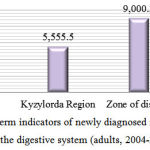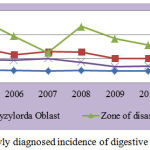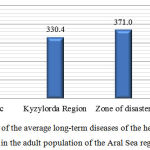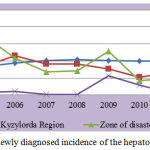Manuscript accepted on :December 11, 2017
Published online on: --
Plagiarism Check: Yes
L. S. Batyrbekova1 and D.H. Rybalrina2
1RSE on PVC Karaganda State Medical University, Karaganda, Republic of Kazakhstan.
2RSE on PVC National Center of Labour Hygiene and Occupational Diseases, Karaganda, Republic of Kazakhstan.
Corresponding Author E-mail: lazat.batyrbekova@mail.ru
DOI : https://dx.doi.org/10.13005/bpj/1301
Abstract
As a result of the study of the incidence of digestive organs in the "disaster" zone of the Aral Sea region, when compared with the republican and oblast indicators, there was a significant excess of 3.6 and 1.6 times, respectively. In the zone of the crisis in the Aral Sea area, a significant excess in relation to the republic was registered, on average, 1.6 times. Mean annual data on diseases of the hepatobiliary system for 2004-2013. in the disaster zone were at the level of the republic, and were above the regional level by 10.9%. The indicators for the medical examination and the survey of the population overlapped the epidemiological data in 11.3 and 4.5 times, respectively. Malignant neoplasms of the digestive system in the disaster zone exceeded the republican level 3 times. A significant correlation between the morbidity and salinity, rigidity, and the index of water pollution in the region was revealed.
Keywords
Incidence of Hepatobiliary System; Priaralye Region; Retrospective Analysis
Download this article as:| Copy the following to cite this article: Batyrbekova L. S, Rybalrina D. H. Analysis of Diseases of the Hepatobiliary System in the Adults of Priaralye. Biomed Pharmacol J 2017;10(4). |
| Copy the following to cite this URL: Batyrbekova L. S, Rybalrina D. H. Analysis of Diseases of the Hepatobiliary System in the Adults of Priaralye. Biomed Pharmacol J 2017;10(4). Available from: http://biomedpharmajournal.org/?p=18097 |
Introduction
Health protection and provision of favorable living conditions for the population is the responsibility of the state in accordance with the Constitution of the Republic of Kazakhstan. During the years of independence, Kazakhstan ensured the formation and consistent implementation of state policy in the field of environmental protection and rational use of natural resources.1,2 To date, a tense ecological situation has developed in many territories of the Republic of Kazakhstan. One of such regions is the region of drying up of the Aral Sea – the largest ecological disaster of anthropogenic origin,3 which spread far beyond the Kyzylorda region, in the zone of the Syrdarya and Aral river basins. Due to the intensive desertification of the Aral Sea, due to unsustainable agriculture with the use of persistent organic pollutants, irreversible processes of environmental degradation of the Aral Sea region, deterioration of living conditions, increase in morbidity occurred, which led to an aggravation of the socioeconomic situation and the adoption of a legislative decision on the legal regulation of measures of social protection of the population living in ecologically unfavorable zones of the region.
The existing environmental ills in the region are reflected in the health of the population, including those manifested in a high incidence rate in the class of diseases of the digestive system.4 Diseases of the hepatobiliary system remain an urgent problem of clinical medicine and attract attention of both practitioners and health care organizers. High sensitivity of the liver to chemical compounds is determined by several circumstances: the liver is the first organ that stands in the way of all xenobiotics trapped in the internal environment of the body and the main body responsible for the metabolism of foreign substances. Changes in the liver in people exposed to toxicants can be difficult to diagnose,5 hepatotoxic effects can develop gradually, for months and even years, while remaining unrecognized,6-7 which requires continuous monitoring and comprehensive medical survey of the population in the region.
To assess the state of incidence rates of the hepatobiliary system in the adult population of the Aral Sea region in 2004-2013.
Materials and Methods
The sources of information about the health of the population were data obtained from the Republican Center for Electronic Health (ECCE), official data according to the report on the number of diseases registered in patients living in the service area of the medical organization and the contingents of patients under dispensary supervision (form 12), as well as data from the annual collection on the state of health of the population in the republic and Kyzylorda oblast.8
According to the law of the Republic of Kazakhstan, adopted by the government on June 30, 1992, with the amendment and addition of 03.07.2013 “On the social protection of citizens affected by the ecological disaster in the Aral Sea region”, three zones of environmental unhappiness have been identified in the region: disaster, crisis and pre-crisis conditions. The main criteria for determining the boundaries of zones of ecological catastrophe and crisis were: 1) a steady increase in the disease and mortality of the population; 2) forced migration for environmental reasons; 3) exceeding the standards for maximum permissible concentrations of pollutants in the environment in terms of life threatening the population; 3) the destruction of ecosystems and the decline in their biological productivity (full or no less than 70
I=Di х100000/N (1)
where: I – Incidence rate;
Di – number of new cases over a period of time I;
N – population in a fixed group.
Epidemiological data were compared with sociological and clinical data. During the medical examination, men and women aged 18-69 (3898 people) were examined with in-depth study of the digestive system by therapists, functional and laboratory diagnostics. The socio-hygienic survey was conducted among the population covered by medical examination and at a courtyard tour. The questionnaire survey involved active citizens aged 18 to 69 years and over (8,574 people). The number of persons for social and hygienic research was 10% of the population, the criterion for inclusion in the study groups was the time of residence in the zone of ecological disaster for at least 10 years. In this study, positive responses to a number of questions were taken into account: “I am worried about heartburn (more than 2-3 times a month)?”, “Do I have attacks of acute zoster, nausea after eating (more than 1-2 times a month)?” , “Do I notice periodic pain in the pit of my stomach, especially on an empty stomach or at night?”, “Do constipation disturb me?”, “Do I have an eating disorder (decrease or increase)?”, “Do I often feel pain in the right hypochondrium?”. The indicators for the sociological and clinical block were translated into intensive ones and were calculated in proshtimilla.
The statistical processing of the results was carried out using the Statistica 10.0 application statistical software package and Microsoft Excel 2007 spreadsheets. Quantitative variables were checked for the normality of the distribution using descriptive statistics data (kurtosis and asymmetry less than 1), Shapiro Wheelk’s criteria (epidemiological data on morbidity), descriptions histogram and check on the line of a normal probability chart (QQ plot). For quantitative variables with normal distribution, the arithmetic mean, variance, standard error and 95% confidence interval were calculated, for quantitative data not subject to the normal distribution law – median, 25% and 75% quartile, mean error.9,10
Results and Discussion
When analyzing the long-term average annual incidence of digestive diseases for the first time in 2004-13, the incidence rate in the zone of ecological catastrophe was 3.6 times higher than in the republic and 1.6 higher in relation to the Kyzylorda region, and in the crisis zone it was 1.6 times higher than the republican data (Figure 1).
 |
Figure 1: Average long-term indicators of newly diagnosed morbidity by the class of diseases of the digestive system (adults, 2004-2013) |
In the Republic of Kazakhstan, the proportion of newly diagnosed morbidity in the prevalence of diseases of the digestive system was 42.0%, and in Kyzylorda Oblast 58.2%.
In the dynamics of the peaks of rising morbidity rates in the disaster zone and the crisis were registered in 2004-05 and in 2008. In the republic, Kyzylorda Oblast and the crisis zone, the dynamics was relatively stable (Figure 2).
 |
Figure 2: Dynamics of the newly diagnosed incidence of digestive organs in the Aral Sea region |
In malignant neoplasms of the gastrointestinal tract in the Priaralye zones, the leading localizations of cancer in the adult population were esophageal cancer (41.1% of the ozone in the disaster zone – 4.7 times higher than in the RK and 35.6% in the crisis zone). (26.3% of ozone in the disaster zone – 1.5 times higher than in the RK and 24.6% in the crisis zone), liver and intrahepatic ducts (15.4% of the ozone in the disaster zone, which corresponds to the high global level – 2.8 times higher than in the RK and 11.5% of ooo in the crisis zone). The mortality rate due to esophageal cancer (40% ooc in the Aral region) was also highlighted, followed by causes of stomach cancer (20%) and liver (10%).
In the structure of mortality, the cause of diseases of the digestive system occupied an average of 5.8% in the region. Mortality due to diseases of the digestive system over the observation period ranged from 20.0 in the Zhalagash district to 50.0% in Kazalinsky district. The analysis of the loss of years for diseases of the digestive organs (YLL, Years of Life Lost) revealed a gender difference, on average in the region, the loss of men was 2 times higher than the female loss of years.
In the zone of ecological “catastrophe”, when there was a comparative analysis of the frequency of newly diagnosed diseases of the hepatobiliary system, an excess over the republican level was not observed on average during the follow-up period, compared to the region as a whole, the excess was 10.9% (Figure 3).
 |
Figure 3: Levels of the average long-term diseases of the hepatobiliary system in the adult population of the Aral Sea region
|
Analysis of the dynamics of the incidence of newly diagnosed diseases of the hepatobiliary system is reflected in Figure 4. The zones of the catastrophe and the crisis are characterized by the instability of the indicators.
 |
Figure 4: Dynamics of the newly diagnosed incidence of the hepatobiliary system over 10 years
|
When comparing the epidemiological indicators of morbidity and the number of diagnoses detected in the medical examination, as well as complaints during the survey, the first were lower at 11.3 (82264.9% of the company) and 4.5 times (32440.0% of the), respectively. This may partly indicate a low circulation of the population for medical care and self-treatment of the population, as well as the donorological potential for loss of health. The data obtained during the medical examination of the population for a block of diseases of the digestive organs were higher than the rest (for diseases of the respiratory, cardiovascular and genitourinary systems). The chronic non-calculous cholecystitis (in 30.9% of the examined patients), chronic hepatopathy (in 26.9% of the surveyed) and their combination (in 29.0% of the surveyed) were most often found in the class of diseases of the digestive organs.
In the study of the correlation between environmental conditions and the incidence of diseases of the digestive organs, an average degree of direct correlation (r = 0.6) was established between the salinity of water, the stiffness and the index of its contamination. By the total hazard index and individual carcinogenic risk, a significant additive proportion of malignant tumors was associated with co-and carcinogenic substances (sulfates, nitrates, phosphates, Cu, Mn, Ni, Cd, Co, Cr, Se).
Among the population living in ecologically unfavorable regions with the existing pollution of water bodies, it is recommended to carry out informative work on the need to clean potable water, by settling, filtering (with periodic filter change) and boiling. When using a decentralized uncontrolled source of water (including spring water), its laboratory analysis is needed. At the heart of high-quality water treatment may be the replacement of pre-chlorination of water by pre-zoning. Owing to oxidative destruction of organic compounds by means of ozone and transfer to non-water-soluble oxides of ions of toxic metals, the latter become less stable in water, and therefore easier to remove during coagulation purification and filtration of water. Finally, the use of modern granular activated carbons at the final stage of purification, makes it possible to obtain sufficiently clean and safe domestic and drinking water.11,12 Although the new methods of water purification do not guarantee the contamination of the already treated water after it has gone through the pipes. As a preventive measure, it may be expedient to use plant enterosorbents.
Conclusion
Thus, as a result of studying the incidence of the digestive tract, the following conclusions can be drawn:
In the “catastrophe” zone, when compared with the republican and regional data, there was a significant excess of the newly diagnosed incidence of diseases of the digestive organs in 3.6 and 1.6 times, respectively. In the zone of crisis, the primary incidence of the digestive tract in relation to the republic was increased 1.6 times.
The average annual data on diseases of the hepatobiliary system in the disaster zone were at the level of the republic, and were 10.9% higher than the regional indices.
The indicators for the medical examination and the population survey overlapped the epidemiological data in 11.3 and 4.5 times, respectively.
Malignant neoplasms of the digestive system in the disaster zone exceeded the republican level 3 times.
Significant correlation dependence between morbidity and salinity, rigidity, index of water pollution in the region was revealed.
Acknowledgement
The work was carried out within the framework of the program “Integrated approaches to health management of the Aral Sea area”.
References
- Kaahstanskiy way – 2050 One goal, common interests, one future. Message of the Head of State N.Nazarbayev to the people of Kazakhstan. Industrial Karaganda. 2014;6(21527):1-3.
- The program on complementary solutions to the problems of the Aral Sea area for 2007-2009 approved by the Government of the Republic of Kazakhstan № 915 of 2006.
- Yu. P. P., Al-Sabunchi A. A., Sheina N. I. The problem of unpredictable anthropogenic impact on the state of the natural environment in countries of South-West Asia. Hygiene and Sanitation. 2013;6:21-25.
- On the social protection of citizens affected by the ecological disaster in the Aral Sea area. Law of the Republic of Kazakhstan No. 1468-XII of June 30, 1992 (as amended by the Law of the Republic of Kazakhstan as of. 2013;124(31)2014:180.
- Alnazarova A. S. The urgency of the problem of the influence of harmful environmental factors of the Aral Sea on the incidence of the population. The latest scientific achievements – 2009: Mater. V Intern. Scientific-Practical. Conf. Sofia. 2009;39-41.
- Myshkin V. A., Bakirov A. B., Ibutullina R. B. Liver involvement with chemicals. Functional-metabolic disorders, pharmacological correction. Ufa: Guillem. 2007;177.
- Khalepo A. N., Ulanova I. P., et al. Investigation of the damage processes of defense mechanisms under the influence of a chemical factor. In In: Sat. tr. Institute of Occupational Medicine of the Russian Academy of Medical Sciences “Actual problems of occupational medicine. Moscow. 2001;25-73.
- Chereshnev V. A., Myshkin V. A., Enikeev D. A. Hepatoprotection in chemical exposures: Monograph. Moscow-Ufa. 2012;202 .
- Health of the population of the Republic of Kazakhstan and the activities of health organizations. Statistical collection. 2004-2013.








